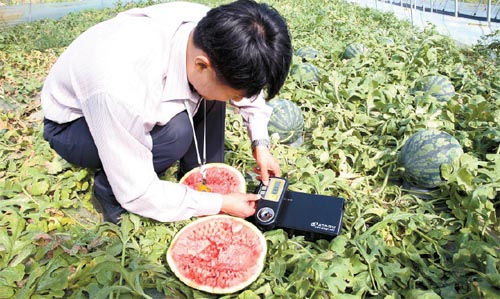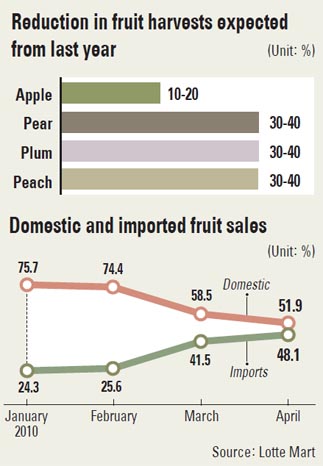Fruit farmers struggle to survive after frost

A buyer at E-Mart checks the sweetness of a watermelon at a farm in Nonsan, South Chungcheong. Due to unusually low April temperatures E-Mart has enhanced checks on fruit sweetness. Provided by E-Mart
Baik Pal-gan, a 44 year-old farmer, took a walk through his peach farm earlier this month in Eumseong, North Chungcheong, and sighed. This should be a busy time for him, thinning out the bulging fruit, but instead he was staring at rows of dry, empty branches.
“This year the trees froze to death,” Baik said, his voice shaking. “Last year we were able to collect 7,000 boxes of peaches, but this year we will only get around one third of that.
“We will have to take out dead trees and plant new ones, but I just can’t bring myself to do that,” Baik said. Also, it would take five years for newly planted trees to bear fruit.
That same day Park Chul-ki, 60, who leads a group of farmers in North Gyeongsang that work on 800 pear trees, dragged on his cigarette in despair. Only 20 to 25 percent of the trees on his farm were fit to be fertilized to bear fruit.
“We will be lucky if we can collect 30 percent of what we had last year,” said Park.
Choi Myung-dal, a 52-year-old farmer working with Park, added, “All we do nowadays is drink from pure anger. Although the government says they are studying the damage, I’m not sure if it will help.”
The farmers in this region last year earned 2 billion won ($1.6 million) from the pear harvest. This year’s earnings are expected to be cut in half.

“Last year 750 farms [in our area] earned 30 billion won, but this year their earnings will be less than half of what they were last year,” said Kim Yoon-gu, who works for Nonghyup’s branch office in Eumseong, which is famous for peaches.
“Farm households big and small were affected by the weather,” Kim said.
Discount retailer Lotte Mart expects this year’s harvest of peaches, plums and pears to fall between 30 and 40 percent from last year, while the apple harvest is likely to drop around 10 to 20 percent.
Farmers have been trying to salvage the fruit and trees damaged by the cold weather.
A watermelon farm in Nonsan, South Chungcheong, added extra vinyl covering to keep the greenhouses warm. The farmers even installed heaters to maintain the balmy temperatures the plants prefer.
An apple farm in Yesan, South Chungcheong, began watering its trees with a solution made from seaweed and vegetables designed to help the damaged trees recover from the frost.
Another farm next door installed a heating fan that automatically activated when the temperature dropped below 3 degrees Celsius (37 Fahrenheit).
“This year’s harvest will see a significant drop because the timing of the trees’ blossoming has been retarded compared to previous years, and even those that succeed in bearing fruit will likely produce disfigured ones,” said Han Wan-kyu, at the apple farm.
The problems in the agricultural industry have led to a crisis for retailers, too, as they struggled to secure sufficient supply. Shinsegae, which operates Korea’s largest discount store chain, E-Mart, has even resorted to signing contracts for individual apple trees - a measure it has never had to take in the past.
Trees with fruit promised to E-Mart are marked with yellow ribbons.
“This method will help us to manage the trees with more intensive care,” said Lee Ho-seong at Shinsegae.
The retailer also enhanced its testing regimen to ensure the fruit are sweet. Last year E-Mart only checked the sweetness level of 60 to 70 percent of its watermelons, selected at random. This year it plans to test it on all of its watermelon, since, Lee said, only three out of five watermelons were passing grade.
Lotte Mart is taking steps to help farmers whose products were damaged by the unusual weather.
“We are planning to buy those fruits that have been damaged and hold various events, including a competition where consumers will choose the ugliest fruit, or we may turn such fruit into juice,” said Shin Kyung-hawn at Lotte Mart. “We plan to come up with other ideas that will help protect farms that are struggling.
Homeplus plans to save by cutting out its 10-percent margin costs spent on distribution, dealing directly with farms rather than the farmers’ union.
With the supply of domestically grown fruit and vegetables shrinking, consumers are relying more on imported goods.
Kim Mi-seong, a 43-year-old housewife, was shopping at Lotte Mart’s Seoul Station branch in downtown Seoul. “I came here thinking of buying domestically grown watermelons or strawberries, but because the prices are so high I’ve decided on imported oranges,” Kim said. “Once you get used to them, imported fruits aren’t that bad.”
According to the retail industry in previous years, imported fruit accounted for 35 to 40 percent of all fruit sold in Korea in April. However, this year that figure has already exceeded 50 percent. Foreign fruit accounted for 48.1 percent of the total sold at Lotte Mart in April, while at GS Supermarket it was 50.7 percent.
Unfortunately for farmers, imports are likely here to stay.
“Unlike in the past, when consumers bought domestically grown fruits even when prices were slightly higher, consumers today have now turned to imported fruit,” said Kim Ran-do, a professor on consumer patterns at Seoul National University.
By Lee Soo-ki, Kim Ki-hwan [ojlee82@joongang.co.kr]










with the Korea JoongAng Daily
To write comments, please log in to one of the accounts.
Standards Board Policy (0/250자)